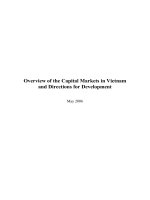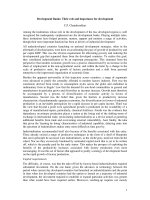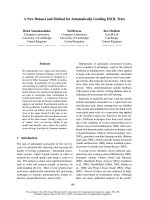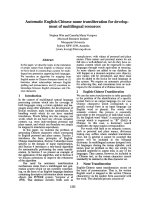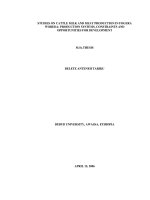Information and Communications for Development 2012 - Maximizing Mobile pdf
Bạn đang xem bản rút gọn của tài liệu. Xem và tải ngay bản đầy đủ của tài liệu tại đây (23.78 MB, 244 trang )
2012
Information and Communications
for Development
Maximizing
Mobile
2012
Information and Communications
for Development
Maximizing Mobile
2012
Information and Communications
for Development
© 2012 International Bank for Reconstruction and Development / The World Bank
1818 H Street NW, Washington DC 20433
Telephone: 202-473-1000; Internet: www.worldbank.org
Some rights reserved
1 2 3 4 15 14 13 12
This work is a product of the staff of The World Bank with external contributions. Note that The World Bank does
not necessarily own each component of the content included in the work. The World Bank therefore does not warrant
that the use of the content contained in the work will not infringe on the rights of third parties. The risk of claims
resulting from such infringement rests solely with you.
The findings, interpretations, and conclusions expressed in this work do not necessarily reflect the views of The
World Bank, its Board of Executive Directors, or the governments they represent. The World Bank does not guaran-
tee the accuracy of the data included in this work. The boundaries, colors, denominations, and other information
shown on any map in this work do not imply any judgment on the part of The World Bank concerning the legal status
of any territory or the endorsement or acceptance of such boundaries.
Nothing herein shall constitute or be considered to be a limitation upon or waiver of the privileges and immuni-
ties of The World Bank, all of which are specifically reserved.
Rights and Permissions
This work is available under the Creative Commons Attribution 3.0 Unported license (CC BY 3.0)
Under the Creative Commons Attribution license, you are free to copy,
distribute, transmit, and adapt this work, including for commercial purposes, under the following conditions:
Attribution—Please cite the work as follows: World Bank. 2012. Information and Communications for Development
2012: Maximizing Mobile. Washington, DC: World Bank. DOI: 10.1596/978-0-8213-8991-1; website: http://www
.worldbank.org/ict/IC4D2012. License: Creative Commons Attribution CC BY 3.0
Translations—If you create a translation of this work, please add the following disclaimer along with the attribution:
This translation was not created by The World Bank and should not be considered an official World Bank translation. The
World Bank shall not be liable for any content or error in this translation.
All queries on rights and licenses should be addressed to the Office of the Publisher, The World Bank, 1818 H Street
NW, Washington, DC 20433, USA; fax: 202-522-2625; e-mail:
ISBN (paper): 978-0-8213-8991-1
ISBN (electronic): 978-0-8213-9587-5
DOI: 10.1596/978-0-8213-8991-1
Cover photographs: Top and bottom: G. M. B. Akash / Panos; center: Mr. Pierre C. Sibiry Traore, ICRISAT, AgCom-
mons, a program executed by the Consultative Group on International Agricultural Research (CGIAR); right: The
Commonwealth of Learning
Cover design: Naylor Design
Table of Contents
Foreword xi
Preface xiii
Acknowledgments xv
Abbreviations xvii
PART I
Executive Summary 3
Tim Kelly and Michael Minges
Main messages 3
Why are mobile phones now considered indispensable? 4
A mobile green revolution 5
Keep using the tablets—how mobile devices are changing health care 5
Mobile money 6
Get a phone, get a job, start a business 6
Using phones to bring governments and citizens closer 6
Onward and upward to mobile broadband 7
Appendixes 7
Infographic: Maximizing Mobile for Development 8
Chapter 1 Overview 11
Michael Minges
How mobile phones are used 13
Data traffic 18
The changing mobile ecosystem 19
Mobile-enabled social and economic trends 22
Structure of the report 27
Notes 27
References 28
v
vi Contents
Chapter 2 Mobilizing the Agricultural Value Chain 31
Naomi J. Halewood and Priya Surya
Making information mobile 31
Improved access to agricultural information 33
Improving data visibility for value-chain efficiency 37
Enhancing access to markets 39
Policy considerations 41
Conclusions 41
Notes 42
References 42
Chapter 3 mHealth 45
Nicolas Friederici, Carol Hullin, and Masatake Yamamichi
Why mHealth? Opportunities and challenges 45
The potential of mHealth 50
The mHealth ecosystem 52
Business models for mHealth 52
Principles for implementing mHealth applications 53
Conclusions 57
Notes 58
References 58
Chapter 4 Mobile Money for Financial Inclusion 61
Kevin Donovan
Mobile money: an ecosystem approach 61
The financial inclusion imperative 62
What is the impact of mobile money? 63
Growing mobile money: challenges
and success stories 65
Emerging issues in mobile money 66
Conclusions 71
Notes 72
References 72
Chapter 5 Mobile Entrepreneurship and Employment 75
Maja Andjelkovic and Saori Imaizumi
Open innovation and mobile entrepreneurship 76
Mobile incubators 79
Mobile microwork 81
Mobiles and recruitment 82
Conclusions and considerations for policy-makers 83
Notes 85
References 86
Contents vii
Chapter 6 Making Government Mobile 87
Siddhartha Raja and Samia Melhem with Matthew Cruse, Joshua
Goldstein, Katherine Maher, Michael Minges, and Priya Surya
A typology of mGovernment 87
Drivers for mGovernment 89
Challenges for governments 93
Enabling the technology transformation 94
Emerging best practices for going mobile 95
Conclusions 98
Notes 99
References 100
Chapter 7 Policies for Mobile Broadband 103
Victor Mulas
The mobile broadband opportunity and developing countries 103
Policy recommendations for facilitating mobile broadband diffusion 104
Conclusions 110
Notes 110
References 111
PART II
Key Trends in the Development of the Mobile Sector 115
Michael Minges
Access 115
Mobile broadband 120
Devices 121
Mobile industry 124
A mobile analytical tool 126
Notes 133
References 134
Data Notes 135
Kaoru Kimura and Michael Minges
Definitions and data sources 138
Mobile at-a-glance country tables 141
Key mobile indicators for other economies, 2010 217
Contributors 219
BOXES
Part I
1.1 Mobile phones and applications 14
1.2 How to make a million from Angry Birds 19
1.3 Smartphones and tablets for development 24
2.1 How Reuters Market Light generates hyperlocalized information 35
2.2 A pregnant pause for Sri Lanka’s cows 36
2.3 Tracking specialty coffee 38
2.4 DrumNet, the value chain on your mobile phone 39
3.1 Kenya: A breeding ground for mHealth applications 48
3.2 Ethiopia: SMS helps in monitoring UNICEF’s food supply chain 49
3.3 India: Health Management and Research Institute—104 Mobile 56
4.1 One device, many channels 62
4.2 Using mobile money 64
4.3 Business models for mobile money 67
4.4 Interoperability and innovation in mobile money 70
5.1 AkiraChix 78
5.2 infoDev’s mLabs and mHubs 80
5.3 Mobile microwork: JANA 82
5.4 Turning ideas into applications: “Mobile To Work” challenge 83
5.5 Business processes for job seekers and employers: Souktel’s JobMatch 84
6.1 The mobile telephone as a tool for citizen voice and empowerment 90
6.2 Kerala’s mobile government program 93
6.3 Evolving toward coordination: the case of the Republic of Korea 94
6.4 Open data and mobile access in Kenya 97
6.5 Challenges to trust and credibility 99
7.1 Using reverse auctions to match spectrum allocations with
coverage obligations in Chile 107
Part II
A.1 Mobile use in rural China 118
FIGURES
Part I
1.1 The developing world: young and mobile 12
1.2 Talking and paying: mobile voice use and price for selected countries, 2010 14
1.3 Mobile phone usage around the world, 2011 16
1.4 Worldwide SMS and Twitter traffic 17
1.5 Data, data everywhere 20
1.6 Apples and Berries: iPhone sales and Blackberry subscriptions 20
1.7 Changing market share of mobile handset sales by operating system 21
1.3.1 Annotated screenshot of Bangladesh’s Amadeyr Tablet 24
1.8 Mapping calls for protest on Facebook to actual “Arab Spring”
demonstrations, 2011 26
1.9 Mobile phone versus internet access household availability 27
3.1.1 MedAfrica app 48
3.2.1 RapidSMS in Ethiopia 49
3.1 Relative popularity of consumer health applications in Apple’s App Store, 2011 51
viii Contents
3.2 Number of countries with at least one mHealth deployment,
by World Bank region 52
3.3 mHealth ecosystem 52
4.1 Different types of mobile financial services 62
4.2 Global mobile money deployments 63
4.3.1 Mobile money demand curves 67
4.3 The most and least expensive remittance corridors 69
5.1 Rewards and risks from entrepreneur participation in social networks 79
5.2 infoDev’s network of mLabs 80
6.1.1 Screenshot of the original Ushahidi mash-up 90
6.4.1 Screenshot from Open Data Kenya website, showing
poverty and pupils per teacher 97
7.1 Broadband subscriptions in selected countries per platform (mobile vs. fixed) 104
7.2 Broadband as an ecosystem where supply and demand factors
interact with each other 104
7.1.1 Mobile broadband subscriptions per operator in Chile 107
7.3 Mobile data traffic by 2016, CISCO forecast 108
7.4 Mobile applications as a driver of mobile broadband demand 110
Part II
A.1 Worldwide fixed and mobile telephone subscriptions 116
A.2 Mobile cellular subscriptions per 100 people, by income group 116
A.3 Mobile household penetration, Senegal and other selected countries, 2009 117
A.1.1 Mobile usage in rural areas of three Chinese provinces, 2011 118
A.4 Population, mobile subscriptions, and poverty headcount
in low- and middle-income economies 119
A.5 Affordability and coverage in developing economies 119
A.6 Mobile broadband 120
A.7 Broadband subscriptions in the Philippines and South Africa 121
A.8 Global sales of mobile and computing devices 123
A.9 Smartphone penetration as a share of population, 2011 124
A.10 Global telecommunication services market 124
A.11 Mobile value chain 125
A.12 Mobile analytical tool: indicators and categories 127
A.13 Mobile analytical tool scores, 2005 and 2010, by income and region group 131
A.14 Mobile analytical tool and GNI per capita, 2010 131
A.15 Mobile analytical tool: China and Sri Lanka compared 132
A.16 Mobile analytical tool components summarized 133
TABLES
Part I
1.1.1 Mobile devices and their capabilities 15
1.1 Top mobile applications, June 2011 18
1.2 Mobile and the Millennium Development Goals 23
Contents ix
2.1 Mobile-enabled solutions for food and agriculture 32
2.2 Impact of ICT on farmers, traders, and consumers 34
3.1 Major categories of mHealth services and applications 46
3.2 Selected examples of mHealth projects and lessons learned 54
6.1 Three types of mGovernment 88
6.2 Policies and programs to promote mGovernment 95
Part II
A.1 Mobile data speeds and volumes, Q3 2011 122
A.2 Private participation in mobile networks, 1990–2010 126
A.3 Worked example of the mobile analytical tool, Morocco 128
A.4 Mobile analytical tool components for 100 selected economies, 2005 and 2010 128
x Contents
xi
Foreword
Mobile phones, a rarity in many developing countries at the
turn of the century, now seem to be everywhere. Between
2000 and 2012, the number of mobile phones in use world-
wide grew from fewer than 1 billion to around 6 billion. The
mobile revolution is transforming livelihoods, helping to
create new businesses, and changing the way we communi-
cate. The mobile phone network is already the biggest
“machine” the world has ever seen, and now that machine is
being used to deliver development opportunities on a scale
never before imagined. During this second decade of the
new millennium, maximizing the potential of mobile
phones is a challenge that will engage governments, the
private sector, and the development community alike.
Information and Communications for Development
2012: Maximizing Mobile is the third report in the World
Bank Group’s series on Information and Communication
Technologies (ICTs) for Development, originally
launched in 2006. This edition focuses on mobile applica-
tions and their use in promoting development, especially
in agriculture, health, financial services, and government.
Cross-cutting chapters present an overview of emerging
trends in mobile applications, the ways they are affecting
employment and entrepreneurship opportunities, and the
policy challenges presented by the ongoing shift from
narrowband to broadband mobile networks. The report
features at-a-glance tables for 152 economies showing the
latest available data and indicators for the mobile sector
(year-end 2011, where possible). The report also intro-
duces an analytical tool for examining the relevant
performance indicators for each country’s mobile sector,
so policy-makers can assess their capacities relative to
other countries. A more complete range of ICT indicators
is available in the Little Data Book on Information and
Communication Technology 2012, published alongside this
report.
It is our hope that this new report will provide some
emerging good-practice principles for policy-makers, regu-
lators, and investors in this complex and constantly chang-
ing sector. The World Bank Group already supports a wide
range of investment lending programs with an ICT compo-
nent. According to the report of the Independent Evaluation
Group, Capturing Technology for Development (2011),
around three-quarters of all investment lending projects
from the World Bank Group have an ICT component; in
addition, more than $4 billion has been invested directly in
the ICT sector between 2003 and 2010.
This report marks a shift from the World Bank Group’s
traditional focus on ICT connectivity to a new focus on
applications and on the ways ICTs, especially mobile
phones, are being used to transform different sectors of the
global economy. This change of focus reflects how the
value created by the industry is shifting from networks and
hardware to software and services. The World Bank Group
expects that the theme of transformation will increasingly
guide its investment lending, and this report is aligned with
that new direction. Ultimately, the mission of the World
Bank is to work for a world free of poverty—a goal that is
likely to be achieved more efficiently when ICT investment
is integrated effectively alongside investment in sectors
such as agriculture, health, and government.
Marianne Fay
Chief Economist, Sustainable Development Network
The World Bank
Foreword
xiii
The World Bank’s new strategy for engagement in the Infor-
mation and Communication Technologies (ICTs) sector,
which comes into force in 2012, is built around three strate-
gic themes: Innovate—ICT for innovation and ICT-based
services industries; Connect—affordable access to voice, high-
speed internet, information and media; and Transform—ICT
applications to transform services for enhanced development
outcomes.
This new flagship report on Information and Communi-
cations for Development builds on these three themes. In
particular, the report shows how innovation in the manu-
facture of mobile handsets—giving them more memory,
faster processing power, and easier-to-use touchscreen
interfaces—married with higher performance and more
affordable broadband networks and services produces trans-
formation throughout economies and societies. Increas-
ingly, that transformation is coming from developing
countries, which are “more mobile” than developed coun-
tries in the sense that they are following a “mobile first”
development trajectory. Many mobile innovations (includ-
ing multi-SIM card phones, low-cost recharges, and mobile
payments) increasingly originate in poorer countries and
spread from there.
Since the last Information and Communications for
Development report was published, almost 2 billion new
mobile phone subscriptions have been added worldwide,
and the majority of these are in the developing world.
This rapid growth does not show the whole picture,
however. Alongside the process of enlarging the network
is an equally important process of improving the quality
and depth of the network as narrowband networks are
upgraded to broadband and as basic phones and feature-
phones are upgraded to smartphones and tablets. The full
range of innovative mobile applications described in this
report is not yet available in all countries and to all
subscribers, but it soon will be. And the expectation is
that developing countries will invent and adapt their own
mobile applications, suited to local circumstances and
needs. For that reason more research is needed on how
mobile applications are used in base of the pyramid
households.
This report, like its predecessors, was researched and
written jointly by the ICT Sector Unit and by infoDev, a
global partnership program of the World Bank Group. It
has been reviewed by a broad range of experts working in
the field, both within and outside the Bank, whose contri-
butions are gratefully acknowledged. Funding is provided
by the World Bank as well as infoDev’s donors, notably the
Ministry for Foreign Affairs of the Government of
Finland, the Korean Trust Fund for ICT4D, and UKaid.
The World Bank Group is committed to continuing its
analytical and lending operations to support progress and
the sharing of best practices and knowledge, as well as
expanding its investments in private ICT companies to
further growth in the sector, competitiveness, and the
availability of better-quality, affordable ICT services to all
the world’s inhabitants.
Juan Navas-Sabater
Acting Sector Manager, ICT Sector Unit
The World Bank
Valerie D’Costa
Program Manager, infoDev
The World Bank
Preface
xv
This report was prepared by a team from the ICT Sector
Unit (TWICT), infoDev, and the Development Economics
Data Group (DECDG) of the World Bank Group. The edito-
rial team was led by Tim Kelly and comprised Nicolas
Friederici, Michael Minges, and Masatake Yamamichi. Their
work was overseen by a peer-review team, led by Marianne
Fay, that included Jose Luis Irigoyen, Valerie D’Costa,
Philippe Dongier, Phillippa Biggs (ITU), and Christine
Zhenwei Qiang.
The principal authors of the chapters in Part I of the
report are:
• Tim Kelly and Michael Minges (Executive Summary)
• Michael Minges (Chapter 1)
• Naomi J. Halewood and Priya Surya (Chapter 2)
• Nicolas Friederici, Carol Hullin, and Masatake
Yamamichi (Chapter 3)
• Kevin Donovan (Chapter 4)
• Maja Andjelkovic and Saori Imaizumi (Chapter 5)
• Siddhartha Raja and Samia Melhem, with Matthew
Cruse, Joshua Goldstein, Katherine Maher, Michael
Minges, and Priya Surya (Chapter 6)
• Victor Mulas (Chapter 7)
The principal authors of Part II were Michael Minges
and Kaoru Kimura, and the editorial team for the statistical
tables comprised Neil Fantom, Buyant Erdene Khaltarkhuu,
Kaoru Kimura, Soong Sup Lee, Michael Minges, and
William Prince.
Inputs, comments, guidance, and support at various
stages of the report’s preparation were received from the
following World Bank Group colleagues: Maria Amelina,
Edward Anderson, Elizabeth J. Ashbourne, Seth Ayers, Alan
Carroll, Vikas Choudhary, Toni Eliasz, Tina George, Joshua
Goldstein, Aparajita Goyal, Siou Chew Kuek, Katherine
Maher, Wonki Min, Fernando Montenegro Torres, Arata
Onoguchi, Tiago Peixoto, Mark Pickens, Carlo Maria
Rossotto, Leila Search, and Randeep Sudan, as well as from
the principal authors.
External reviewers, to whom special thanks are owed,
included Phillippa Biggs (ITU), Steve Esselaar (Intelecon),
Shaun Ferris (Catholic Relief Services), Vicky Hausmann
(Dalberg), Janet Hernandez (Telecommunications Manage-
ment Group), Jake Kendall (Gates Foundation), Vili
Lehdonvirta (London School of Economics), Daniel Leza
(Telecommunications Management Group), Bill Maurer
(University of California, Irvine), Sascha Meinrath (New
America Foundation), Marcha Neethling (Praekelt Founda-
tion), Brooke Partridge (Vital Wave Consulting), Ganesh
Ramanathan (Tiger Party), Michael Riggs (Food and
Acknowledgments
xvi Acknowledgments
Agriculture Organization), Stephen Rudgard (Food and Agri-
culture Organization), Brendan Smith (Vital Wave Consult-
ing), Scott Stefanski (Bazaar Strategies), Heather Thorne
(Grameen Foundation), Katrin Verclas (Mobile Active), and
Anthony Youngblood (New America Foundation).
Special thanks are owed to Phillippa Biggs (ITU), who
provided a thorough and dedicated peer review of all chap-
ters, as well as to Denis Largeron and Marta Priftis from
TWICT, and to Denise Bergeron, Jose De Buerba, Aziz
Gökdemir, Stephen McGroarty, and Santiago Pombo-
Bejarano, from the World Bank Office of the Publisher for
oversight of the editorial production, design, printing, and
dissemination of the book. The infographic in the Executive
Summary was prepared by Zack Brisson and Mollie Ruskin
of Reboot (www.thereboot.org), with guidance from the
editorial team.
A report of this nature would be impossible without the
support of our development partners. For this edition of the
report, special thanks are due to:
• The Ministry for Foreign Affairs of the Government of
Finland for its support for the Finland / infoDev / Nokia
program on Creating Sustainable Businesses in the Knowl-
edge Economy, which supported the production of the
report as well as research for chapters 1, 2, 4, and 5.
• The Korean Trust Fund (KTF) on Information and
Communication Technology for Development (ICT4D),
which supported background research for chapters 2, 3,
4, and 5.
• UKaid, which supported background research for chapter
7 through its support for infoDev’s analytical work
program.
The team would also like to thank the many other indi-
viduals, firms, and organizations that have contributed
through their continuing support and guidance to the work
of the World Bank Group over the three years since the last
report in this series was published.
2G second generation (mobile
communications)
3G third generation (mobile
communications)
4G fourth generation (mobile
communications)
apps applications
ATM automated teller machine
CDMA Code Division Multiple Access
(cellular mobile standard)
CGAP Consultative Group to Assist the Poor
e-payment electronic payment
e-services electronic services
ebook electronic book
eCommerce electronic commerce
EDGE Enhanced Data Rates for GSM
Evolution (cellular mobile
standard)
eGovernment electronic government
eHealth electronic health
EV-DO Evolution–Data Optimized (cellular
mobile standard)
GB gigabyte
GDP gross domestic product
GNI gross national income
GPS Global Positioning System
GSM Global System for Mobile
communications
GTUGS Google Technology User Groups
HSPA High-Speed Packet Access (cellular
mobile standard)
HTML hypertext mark-up language
IC4D Information and Communications
for Development
ICT information and communication
technology
IM instant messaging
IMF International Monetary Fund
ISP internet service provider
ITU International Telecommunication
Union
kbit/s kilobits per second
LTE Long Term Evolution (cellular mobile
standard)
MB megabyte
Mbit/s Megabits per second
MDGs Millennium Development Goals
mGovernment mobile government
mHealth mobile health
mLab mobile applications laboratory
xvii
Abbreviations
NFC near field communications
NGO nongovernmental organization
OECD Organisation for Economic
Co-operation and Development
PC personal computer
PDA personal digital assistant
PPP public-private partnership
RFID radio frequency identification
SAR special autonomous region
SIM subscriber identity module
SME small and medium enterprise
SMS short message service
TCO total cost of ownership
TD-SCDMA Time Division Synchronous Code
Division Multiple Access (cellular
mobile standard)
UNCTAD United Nations Conference on Trade
and Development
UNDP United Nations Development
Programme
UNESCO United Nations Educational, Scientific
and Cultural Organization
UNICEF United Nations Children's Fund
USB universal serial bus
USSD Unstructured Supplementary
Service Data
W-CDMA Wideband Code Division
Multiple Access (cellular
mobile standard)
WHO World Health Organization
WiMAX Worldwide Interoperability for
Microwave Access (wireless standard)
xviii Abbreviations
All dollar amounts are U.S. dollars unless otherwise indicated.
Part I

